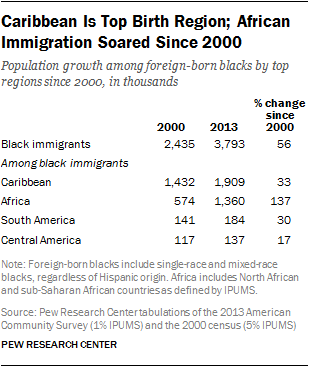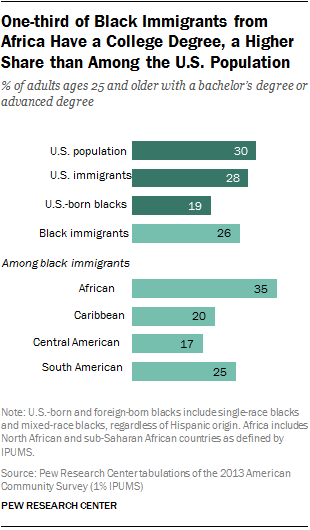Black immigrants make up a small but growing segment of the U.S. black population. Although the United States has long had a sizable black population as a legacy of slavery, voluntary black immigration to the U.S. is a relatively new development and is projected to grow in the coming decades. A new Pew Research Center report examines this trend and provides a statistical portrait of the nation’s black immigrant population.
Here are six key findings about the foreign-born black population in the U.S.

The black immigrant population has more than quadrupled since 1980. Only around 800,000 blacks were foreign-born in that year, and by 2013 the number had climbed to 3.8 million, according to a Pew Research analysis of U.S. Census Bureau data. Immigrants are also making up a larger share of the overall black population – 8.7% of blacks were foreign-born in 2013, a share that is projected to almost double by 2060.
The number of black immigrants from African nations has rapidly grown. Between 2000 and 2013, the black African immigrant population grew from 570,000 to 1.4 million, an increase of 137%. Africans make up 36% of the overall foreign-born black population, up from 24% in 2000. Still, half of all black immigrants were born in the Caribbean, with Jamaica and Haiti being the two largest birth countries, accounting for 18% and 15% of black immigrants, respectively.
Black immigrants make up a double-digit share of the overall black population in some large metro areas. In 2013, about one-in-three blacks (34%) living in the Miami-Fort Lauderdale-West Palm Beach metro area in Florida were immigrants. In the New York-Newark-Jersey City metro area, foreign-born blacks made up 28% of the black population. And in the Washington, D.C., metropolitan area, 15% of the area’s blacks were foreign-born.
When compared with U.S. immigrants overall, foreign-born blacks are less likely to be in the U.S. illegally, more likely to be U.S. citizens and more likely to speak English at a higher rate. About 575,000 black immigrants were living in the U.S. without authorization in 2012, accounting for 16% of all black immigrants, according to Pew Research Center estimates. By comparison, about a quarter of the nation’s 42.5 million immigrants have an unauthorized status. Black immigrants are also more likely to be U.S. citizens than immigrants overall (54% versus 47%). And given that many black immigrants are from English-speaking Caribbean nations, 74% of those ages 5 and older are proficient in English, compared with 50% of all immigrants.

Overall, black immigrants earn college degrees at a slightly lower rate than Americans in general, but the share of foreign-born blacks from Africa with a college degree is higher than that of the overall U.S. population. About one-quarter (26%) of foreign-born blacks ages 25 and older had at least a bachelor’s degree in 2013, which falls somewhat below that of the overall U.S. population, at 30%. However, black immigrants ages 25 and older from Africa have high levels of educational attainment – 35% have a college degree, a higher share than Americans overall.
There are some distinct differences between U.S.- and foreign-born blacks when it came to age, education, marriage and income. In comparison with U.S.-born blacks, foreign-born blacks are older, with a median age of 42 versus 29 for U.S.-born blacks, according to 2013 figures. Among those 25 and older, a higher share of immigrant blacks have a bachelor’s degree or higher (26% vs. 19%). They’re also much more likely to be married – nearly half (48%) of black immigrants ages 18 and older were married in 2013, compared with 28% of U.S.-born blacks, a difference that may be tied to the foreign-born blacks’ higher median age. Black immigrants are in general faring better economically than blacks born in the U.S. Household incomes for foreign-born blacks are on average $10,000 higher than U.S.-born blacks, and black immigrants are less likely to live in poverty (20% vs. 28%).
